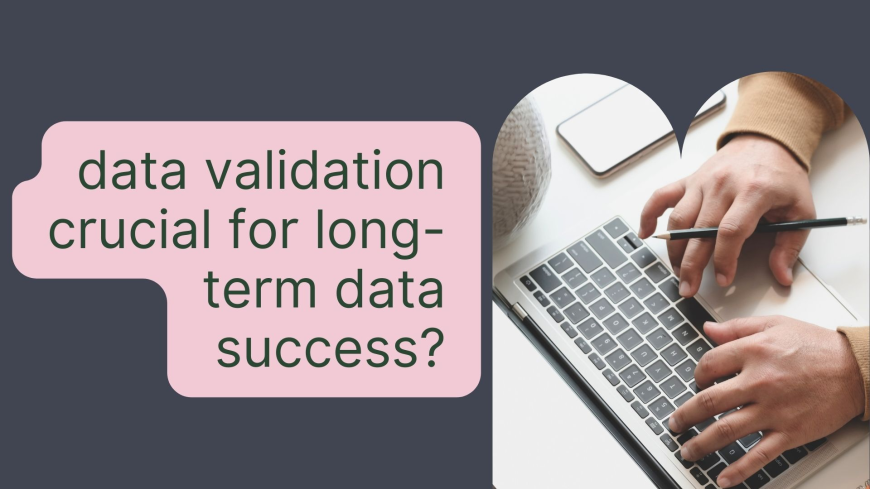Why is data validation crucial for long-term data success?
Learn how clean, accurate data improves decision-making, reduces costs, boosts customer trust, and supports compliance.

Data validation is a critical process that ensures the accuracy, completeness, and reliability of data throughout its lifecycle. In an era where data drives decision-making, the importance of data validation cannot be overstated. This article explores why data validation is essential for long-term data success, highlighting its processes, benefits, and challenges.
What is Data Validation?
Data validation is the process of checking and ensuring that data is correct, clean, and useful before it's stored, processed, or analyzed. It helps confirm that the data:
-
Follows the correct format (e.g., phone numbers, dates)
-
Is within the expected range (e.g., age must be a positive number)
-
Is complete (no missing values in required fields)
-
Matches existing records (e.g., matching user IDs with correct user info)
This process can happen when data is entered (real-time validation), imported from other systems, or during regular database checks
Why Does Data Validation Matter for Long-Term Success?
Here are the main reasons why data validation is critical for maintaining long-term data integrity and business success:
1. Improves Decision-Making Accuracy
When data is incorrect or inconsistent, decisions based on it can lead to poor outcomes. Imagine a retail company forecasting demand based on flawed sales data — it might overstock or understock, leading to financial loss.
Validated data = more accurate insights = better decisions.
2. Prevents Costly Errors
Bad data costs businesses millions of dollars each year. Errors like duplicate entries, incorrect billing info, or outdated customer contact details can result in wasted resources, lost sales, and reputational damage.
By catching issues early through data validation, organizations can avoid these costly mistakes.
3. Supports Compliance and Legal Requirements
Industries like healthcare, finance, and insurance have strict data handling regulations (e.g., HIPAA, GDPR). Validated data ensures compliance, helping businesses avoid legal trouble, fines, and security risks.
4. Enhances Data Integration Across Systems
Most organizations use multiple systems — CRMs, ERPs, analytics tools, etc. For these to work together smoothly, the data needs to be consistent and clean.
Data validation ensures that information shared across platforms is accurate and compatible, making integration easier and more reliable.
5. Boosts Customer Trust and Experience
Customers expect businesses to know them — and know them accurately. If your customer data is outdated or incorrect (wrong names, emails, or preferences), it can lead to frustration and loss of trust.
Clean data helps personalize experiences and build stronger relationships with customers.
Types of Data Validation
Several types of data validation techniques can be applied depending on the data source and purpose:
-
Format validation: Ensures data follows a predefined pattern (e.g., email addresses, ZIP codes).
-
Range validation: Confirms that values fall within acceptable ranges (e.g., temperature between -50°C and 60°C).
-
Consistency checks: Verifies data across systems or fields (e.g., delivery date must be after the order date).
-
Uniqueness checks: Prevents duplicate records in databases.
-
Presence checks: Ensures required fields are not left empty.
Common Challenges in Data Validation
Even though data validation is essential, it’s not always easy. Some common challenges include:
-
High volume of data: Manually validating large datasets is time-consuming and prone to errors.
-
Data from multiple sources: Data collected from different platforms may have varying formats and quality.
-
Evolving data rules: Validation rules need to adapt as business needs or regulatory requirements change.
-
Human error: Incorrect data entry or inconsistent handling can still slip through, especially without automation.
How to Implement Effective Data Validation
To ensure effective long-term data validation, consider these best practices:
-
Define clear data standards and rules: Set specific formats, values, and requirements for each data type.
-
Use automation and validation tools: Leverage software tools to automatically check and clean data in real-time or during processing.
-
Validate data at every stage: Don’t wait until data is stored — validate during entry, transfer, and storage.
-
Train your team: Ensure employees understand the importance of accurate data and follow best practices.
-
Perform regular audits: Periodically review your databases to catch any issues that may have been missed.
-
Document and monitor validation processes: Keep track of what rules are in place, how they’re applied, and how often they’re reviewed.
Real-World Example
Let’s say an e-commerce company collects customer data for online orders. If phone numbers are entered without validation, one customer might enter “123456” while another uses “+1-800-555-0199”. Without standardized formatting, automated SMS notifications could fail or reach the wrong people. With proper validation in place, the system ensures only valid phone numbers in a standard format are accepted.
Final Thoughts
Data validation is not just a technical task, it’s a strategic investment. Clean, validated data supports better decision-making, improved customer experiences, cost savings, and long-term business success. As organizations continue to rely more heavily on data, the importance of validation will only grow.
Whether you're managing enterprise-level systems or starting out with a data analytics certification course in Noida, Delhi, Faridabad, and other parts of India, understanding and applying data validation techniques will be key to leveraging data as a reliable asset.


 sanjeetsingh
sanjeetsingh 

